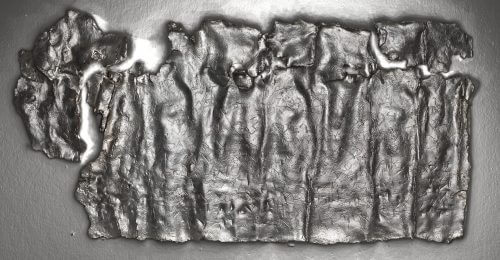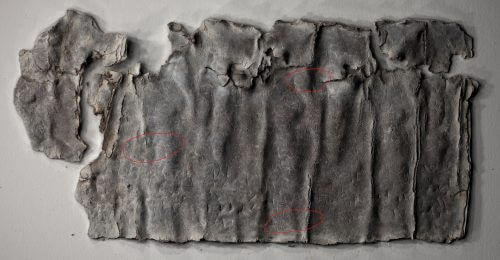To date, such plaques have only been found in Greek or Latin, and there has been no evidence that Jewish fans cursed horses.

A surprising discovery: a Jewish curse plate from the fifth or sixth century AD was deciphered, which was buried under the hippodrome in the city of Antioch (today in the southern part of Turkey), with the aim of tripping the competing team's horses. The tablet was written in Aramaic and Hebrew letters, and even makes magical use of the biblical story of Balaam's death.
Responsible for the discovery is Rebecca Elitzur-Leiman, a doctoral student from the School of Jewish Studies and Archeology at Tel Aviv University, and Dr. Margareta Fulmer from Leiden University in the Netherlands. Elitzur-Layman will present the results of her research tomorrow, May 17, as part of a TED-style short lecture marathon that will be held at Tel Aviv University and will present the best research of the outstanding doctoral students at the School of Jewish Studies.
"The topic of my PhD is Jewish amulets from the Byzantine period," Elitzur-Leyman explains. "Most of these amulets are designed to protect their owners from various harms - to protect against the evil eye, to drive out demons and even to ensure a legal victory in court. Throughout the Greek, Roman and Byzantine world, and also here in the Land of Israel, the protective amulets were actually a thin plate of gold, silver or copper, on which the spell was engraved. After the engraving, roll up the plate, place it in a small pouch and wear it on the body."
But there was also another type of such plates - plates that contained curses. The Greeks and Romans would prepare the curses from lead, which they considered an effective material for cursing.
"The curses were used for a variety of purposes," says Elitzur-Layman, "such as curses imposed on enemies or falling in love curses. Yes, love spells were also considered curses, because they were violent in nature. For example, they used to curse a woman that she would not be able to eat or drink anything until she fell in love with the person who wrote the curse."

Among the curse plates, a common type was curses for chariot racing, which was a very popular sport in the Byzantine period. "Much like football these days, crowds adored different sets of vehicles and horses. They gambled on their performance and even resorted to 'black' magic to influence the outcome of the game. Among other things, the fans would write curse plates against the vehicles and horses of the competing team, and bury them under the hippodrome floor - so that the curse would work when the horse passed over it."
To date, such curses have only been found in Greek or Latin, and there has been no evidence that Jewish fans cursed horses. Although in the ancient Jewish book of sorcery, "The Book of the Thin", there is a magical recipe for invigorating horses, but there was no proof that this curse was actually carried out. Now, Elizur-Leiman has deciphered for the first time a Jewish curse tablet from the fifth or sixth century AD found in the Hippodrome of Antioch.
"The archaeological excavations at the Hippodrome in Antioch were already carried out in the 30s, and indeed they found various curses for horse racing in Greek. However, one plate that was discovered remained closed, because a nail was stuck in it. In general, nails driven into plates were supposed to enhance the magical power of the object, and the effect of the spell. And so the plate was displayed in the Princeton University Museum as an example of a nailed curse plate. A few years ago the curators of the museum decided to pull out the nail and read the plaque. To their surprise, the language of the spell was Aramaic."
From there, the object came into the hands of Rivka Elitzur-Leiman from Tel Aviv University and Dr. Margareta Fulmer from Leiden University, who managed to decipher its contents.
"This is a Jewish curse plate, written in Hebrew letters similar to the ones we use today, and intended to harm the blue team in the race (in Aramaic: "Benet"/"Benita"). The author of the talisman was not content with translating Greek curse texts, but used the biblical story of Balaam's death: the curse calls for an angel standing in front of Balaam's death to also block the horses of the opposing team. Sages did forbid the holding of horse races, and certainly would not have liked the idea of using such magicians, but in doing so we proved that Jewish fans also cursed their competitors."
More of the topic in Hayadan:

4 תגובות
The response of Dr. Yehiam Sorek
Well, first of all - Sages did not forbid the participation or watching of Jews in chariot driving competitions at all. More than that, they even encouraged Jews to watch contests between gladiators for the sake of saving lives, or as the sources use the reasoned expression: "because he screams and saves", referring to the cries of the crowd in favor of saving the life of this or that gladiator, especially when it comes to a Jewish gladiator.
Secondly, in the classical Greek hippodrome, columns or statues were placed in the corners of the grounds called "Taraxipus", meaning "horror of the horses", which were intended to challenge (frighten) the chariots in the dramatic moments of a round turn, and the chariots, before every competition, would make sacrifices near those buildings and present offerings.
Third, the list mentions the "blue faction". Well, in the Roman sport that was an eternity away from the Greek one, since the Roman sport was part of "bread and fun", and from that it was touched by gambling. The riders operated from clubs or "factions" known by their four colors: first white and red, and later also blue and green. Rabbi Yoḥanan bar Nafcha of Tiberias provides a detailed and interesting testimony about those sect-associations and in the process details the structure of the Roman "Kirkos" on all its parts and components, including those four colors. And to remind us that in Tiberias an ancient Roman building was revealed as a kind of complex consisting of a theater and a kirkos that touch each other.
The Jewish audience, especially in the Roman cities in the Land of Israel, was definitely steeped in Latin culture, including in various sports contexts. The tablet that was found and is relevant to our case is interesting and emphasizes the opposite of the biblical vision from the mouth of Balak/Balaam - "They shall dwell alone and the Gentiles shall not be considered"
very interesting
Nice article. When you look at the Jews in all periods, you see that a large part of them were pleasure-loving, materialistic, beauty-loving like all humans, gamblers.
I wonder if in the future they will be just as enthusiastic about the curses of the modern rascal?